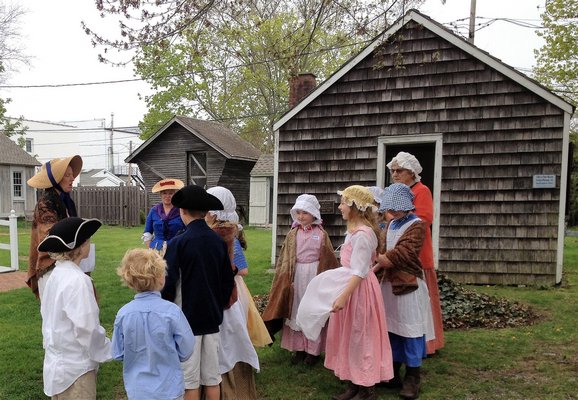
French brothers Francois and John Fournier were among the first people to arrive in Red Creek—a small community nestled in northern Hampton Bays—during the American Revolution. After settling in the Colony of New York in August 1776, the young men joined the patriots to fight Britain in the Battle of Long Island. Despite their best efforts the Fourniers were captured by the British and forced onto a prison ship in Gravesend Bay in Brooklyn, recounted Brenda Sinclair Berntson, the president of the Hampton Bays Historical & Preservation Society. The Fourniers managed to escape and take a small boat to sail across the Long Island Sound, through Peconic Bay, and into Red Creek, where they ultimately hit a reef that completely wrecked the ship.
Stuck there, the Fourniers used the wood from the shipwreck to build their house.
Other structures from early Red Creek still exist, including the Red Creek Schoolhouse that will be restored with a grant recently awarded to the Southampton Historical Museum in Southampton Village.
Nestled between Peconic Bay and Red Creek Pond, Red Creek was among several hamlets—including Southport, Squiretown, Newtown, Canoe Place, Ponquogue, Springville and Tiana—that would come to be collectively known as Good Ground before the area’s name was changed to Hampton Bays.
When the Fourniers were living in Red Creek it was much different from the way the quiet, wooded area looks today. It was a busy little town with workers building whaling ships, manning a fish oil factory, and running a trading post. Red Creek was populated by people of many trades including carpenters, farmers and fishermen.
It was also home to the Red Creek Schoolhouse, which was built in the 1830s. The Southampton Historical Museum bought the schoolhouse for $400 in 1953 from William Hubbard, who had been using it to store boats. The schoolhouse was then moved to Southampton Village. The structure had to be lifted off its foundation and moved onto a barge, which floated the building through the Shinnecock Canal and into Shinnecock Bay, and then to Southampton, according to Emma Ballou, a curator and registrar at the museum.
Last month the Robert D.L. Gardiner Foundation, which supports nonprofit historic foundations that promote New York State history, awarded a $50,500 matching grant to the museum to restore the schoolhouse, which sits on the grounds on the museum’s Rogers Mansion on Meeting House Lane.
The schoolhouse has become a popular attraction for Southampton students who visit the museum to learn about the education and work activities of children nearly two centuries ago.
Red Creek also had its own small cemetery sitting on the north side of Red Creek Road—though the graveyard’s official name is disputed by local historians. Some believe it was named “Fournier Cemetery,” after the notable French family buried there, while others suggest it was called “Squires Burying Ground,” as a member from the Squires family is interred there as well.
Though the name of the cemetery is unclear, there is one thing that will never be disputed: Red Creek was rich with history.
About a century before the Fourniers arrived at Red Creek, the area was occupied by the Yeanocock Indians, who were best known for being “money makers,” according to Ms. Berntson. She explained that they would make money called wampum out of clam shells, so they could make transactions with other tribes, including the Shinnecocks.
When the area was occupied by Native Americans, it was referred to as Tow Youngs, according to a report about the Red Creek Schoolhouse written last year by Sally Spanburgh, who chairs the town’s Landmarks & Historic Districts Board. She compiled the report to show that the schoolhouse is, indeed, a historic structure.
Ms. Spanburgh explained in the report that Red Creek was a coveted area to the Native Americans, as it was one of the rare places that were filled with shells for wampum.
The area was also used as a landing for ships importing and exporting goods, explained Southampton Town Historian Zach Studenroth. These landings inspired some of the road names that still exist in the Hampton Bays—including West Landing Road and East Landing Road.
“These landings were quite common around [Red Creek],” Mr. Studenroth said.